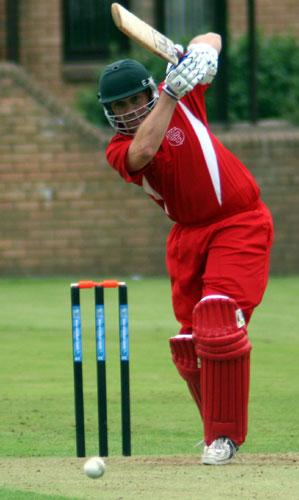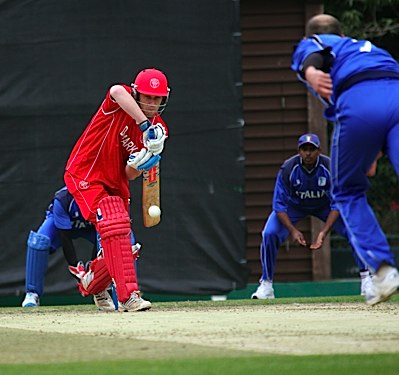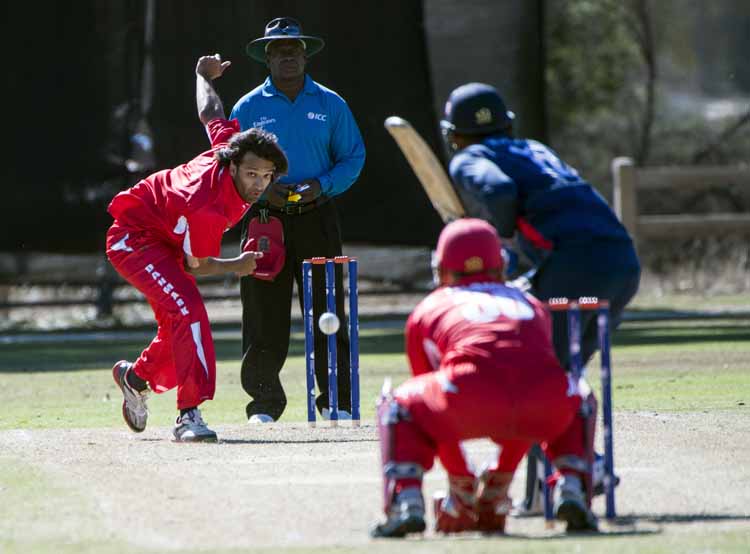It is not known precisely when cricket was introduced to Denmark but it seems likely that by the time records of matches first appeared in 1865, the game had already been in existence for several years.
The 1860s saw two separate movements influence the development of cricket. First, the game was played by workers of the Danish Railway network which was being constructed under the supervision of British engineers. In 1865 the railway men started a club in Odense, on the island of Funen, although it is not known how many Danes were members. Railway engineers were also playing the game in Zealand and Jutland.
The first recorded cricket match in Denmark took place in the same year at Randers though it is not certain whether this was between teams of railway engineers, or, as suggested by the Danish cricket historian, Douglas Steptoe, between the Aalborg and Randers Cricket Clubs.
Meanwhile in Copenhagen the game was being introduced by a small group of the aristocracy, centered on the Hansen family, who had learned the game in England. The brothers, Professor Edmund Grut-Hansen, Harald Hansen and Gustav Hansen, together with their brother-in-law, Professor Peter Plum, a physician-in-ordinary to the Russian Empress Dagmar, and Captain of the Engineers, V Hoskjaer, were key members of the Copenhagen Ball Games Club, which is known to have existed as ear;y as 1861. They encouraged club members to take up the game. They were also influential in persuading a physics teacher, Napoleon Eugen Ibsen, to introduce the game at the Soro Academy.
Of the two routes by which the game developed, more is known of the aristocratic one. Cricket was introduced at a second public school, Herlufsholm, and the game was played enthusiastically by the Ball Games Club under the captaincy of Lieutenant-Colonel Hilarius-Kalkan. Unfortunately when he was posted by the military to Hesingor, interest declined and the game in Copenhagen nearly died out. Cricket though was rescued by the efforts of two old boys of the Soro Academy, VC Petersen and Ludvig Sylow. In 1879, they formed the Kobenhavns Kricket Klub which in 1882 amalgamated with the Kjobenhavns Boldklub, later to become one of the leading clubs in Denmark.
In 1887 the KB side tested their strength in three matches against the officers and men of the Prince of Wales’ Royal Yacht Osborne which was on a visit to Copenhagen. KB won the first game by eight wickets, drew the second and lost the third by 13 runs. These matches were important because it was the first time that overarm bowling was seen in the country.
 Carsten Pedersen during his unbeaten 65 against Ireland in the 2006 European Championship in Scotland
Carsten Pedersen during his unbeaten 65 against Ireland in the 2006 European Championship in Scotland
By 1880, cricket was also well-established at several centres in Jutland. In 1889, Albert Ginge, who set up his export business in Danish bacon at Hjorring, founded a club there which has been a leading centre for the game ever since. Young students from Frederica founded the Frederica Students CC when they went to study at Copenhagen University. Club membership was quickly opened to all students at the University and also to students of the Polytechnic Institute as well, forming the Akademisk Boldklub, which became a rival to KB for the position of the leading club in Copenhagen. The same year also saw the establishment of the Danish Ball Games Union to organise football and cricket club for the whole country.
Until the 1890s most cricket took place on rough grass wickets or on gravel, usually on public commons, military parade grounds or other public and waste ground. Once overarm bowling became the norm, these surfaces proved extremely dangerous and clubs started to develop their own private grounds where games could be played on matting. The game thus became focused on clubs and a few elite schools. Although it was established in virtually all the main towns, it was primarily a minority sport of the well-educated and the wealthy. In this condition, the game started to stagnate and little progress was made before the First World War.
 Freddie Klokker was Player of the Tournament at the 2008 European Championship
Freddie Klokker was Player of the Tournament at the 2008 European ChampionshipAfter 1918 steps were taken to improve the standard of play. Coaching manuals were imported and through the offices of RP Keigwin, a master at Clifton College in England and an expert on Danish history and poetry, arrangements were made for the MCC to tour in 1922. A further tour was made in 1925 when the MCC visited Jutland and Copenhagen. The following year saw the first tour to England, but costs and time meant the team was not fully representative of Danish cricket. It was also the first time that the players had experienced grass wickets. Although only one match out of seven was won, with three drawn, the results were promising.
The Icogniti side visited in 1927 and 1929, being shocked as they were dismissed for only 27 at Hjorring but they managed to salvage a draw. Folowing this tour, Baron H Rosemktantz, who was one of the 1926 tourists to England and a patron of cricket in the English style, organised the finance for HP Chaplin of Sussex to come and coach in Jutland. In 1929 a group of enthusiasts in Copenhagen formed the Cricket Ring with the aim of organisng tours to Denmark by English teams. The Gentlemen of Worcestershire came in 1930 and in 1932 Sir Julien Cahn brought a side. This saw the selection of the first all-Denmark side for an international match. Two games were played, both won by Cahn’s XI. No further international matches were played until 1939 when the Danes managed a draw with the MCC at Aalborg.
Cricket was revived rapidly after the Second World War thanks to the presence of British military units stationed in Denmark and just across the border in Germany. Cambridge University visited in 1947 and the MCC in 1950 and 52. These tours showed that while the Danish bowling was of a reasonable standard, their batting lagged behind. The Copenhagen Cricket Ring raised the issue with the DBU, asking them to take action and provide proper coaching facilities. The Committee of the DBU however were dominated by people who were only interested in football and were happy to see cricket decline to a point when it could be removed from their responsibility.
Against this background, Kurt Nielsen, the Chairman of the Copenhagen Ball Games Union, and Henry Petersen, almost a lone voice for cricket within the DBU, established the Dansk Cricket Forbund (Danish Cricket Union) in 1953 as the governing body. In the same year, Denmark embarked on their second tour of England, winning three of the eight matches played against club sides. Oxford University visited Denmark in 1954 and in 1955 the international series of matches against The Netherlands was started. It was not until 1973 when they gained their first win, by ten wickets. The two-day games switched to one-day matches in 1980.
 Freddie Klokker batting against Namibia in the 2007 World Cricket League 2 match in Windhoek
Freddie Klokker batting against Namibia in the 2007 World Cricket League 2 match in Windhoek
They gained membership of the ICC in 1966, and the 1970s was a very successful decade for Danish cricket. In addition to matches against the Dutch, a regular series was started with Ireland. The first tours outside of Europe were undertaken with visits to Canada and East Africa. In 1979, Denamrk reached the semi-finals of the ICC Trophy where they lost to a strong Sri Lankan side. The decade also saw the emergence of women’s cricket. Surprisingly, there was considerable prejudice on the part of the Danish cricket authorities to the women’s game but, by the end of the 70s, an annual championship for women’s clubs had been inaugurated. They played in the 1993 and 1997 World Cups, and gained wins against both The Netherlands and Pakistan.
The men’s game suffered from financial difficulties in the 1980s and they were unable to afford the expense of playing in the 1982 ICC Trophy, but returned in 1986 where they again reached the semi-finals where they lost a play-off against The Dutch. Ole Mortensen became the first Dane to play county cricket in 1983 and he went on to have a stellar career with Derbyshire. Overall the 1980s and 1990s were a time for consolidation rather than development for what still remained a minority sport with limited spectator appeal and played by a small group of enthusiastic amateurs. The best players were often bowlers or all-rounders which meant that, whilst the Danish side could often bowl the opposition out, they did not have the batting to score defendable totals.
The year 1989 was one of the most successful in Danish cricket history. For the first time they beat the Dutch in The Netherlands, winning the one-day fixture by 33 runs. They scored 438 and dismissed Italy for 29, winning a 40-overs match by 409 runs. The end of the summer saw the first visit to Denmark by an international Test team when Australia played two one-day matches after their Ashes tour to England.
The visit attracted over 4,000 people to the games. The Australian batting struggled against the Danish attack led by Ole Mortensen but the batsmen could make little impression against the Australian bowlers. The only player to impress was Aftab Ahmed who made 77 not out in the second game.
 Michael Pedersen batting against Italy in the 2011 WCL 3 match in Hong Kong
Michael Pedersen batting against Italy in the 2011 WCL 3 match in Hong Kong
Aftab was representative of a major change that was taking place in Danish cricket, namely the emergence of a large number of Pakistani players. By the early 1990s, three all-Pakistani sides had been formed in Copenhagen, namely Norrebro, Ishoj and Albertslund. By the mid-1990s the KB junior side was almost entirely Pakistani. It was from this stable that Amjad Khan emerged as the prospective replacement for Ole Mortensen as Denmark’s strike bowler. However, he chose to follow a successful first-class career with Kent and became a British citizen becoming the first Dane to play Test cricket when he made his only appearance, against the West Indies in Port-of-Spain in 2009. Knee injuries restricted his impact, but he did return to play for the Danes in 2016 in Los Angeles in the World Cricket League.
Their ICC Trophy record stands at 26 wins and 20 losses, with two third-place finishes. Henrik Mortensen (8-84) is their best bowling display, while Carsten Pedersen’s 197 against Namibia is their highest individual score.
They have played in 12 European Division One tournaments from 1996, winning the 2011 tournament held in Jersey by beating Italy. They finished runners-up in 2013 and 2015 as well, qualifying for the T20 World Cup qualifiers.
 Aftab Ahmed bowling against USA at the 2016 WCL 4 tournament in Los Angeles.
Aftab Ahmed bowling against USA at the 2016 WCL 4 tournament in Los Angeles.
In the World Cricket League they were relegated from Division Two and Three before finding their feet in Division Four staying there in 2012, 14, 16 and 18, winning promotion in the latter.
They have played seven T20Is to date winning four and losing three to be currently placed 29th in the ICC rankings.
This article was first written by Roy Morgan in 2006 and has been updated by CricketEurope.

